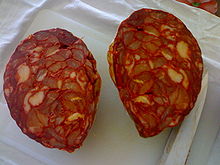
Abruzzo, historically known as Abruzzi, is a region of Southern Italy with an area of 10,763 square km and a population of 1.3 million. It is divided into four provinces: L'Aquila, Teramo, Pescara, and Chieti. Its western border lies 80 km (50 mi) east of Rome. Abruzzo borders the region of Marche to the north, Lazio to the west and north-west, Molise to the south and the Adriatic Sea to the east. Geographically, Abruzzo is divided into a mountainous area in the west, which includes the highest massifs of the Apennines, such as the Gran Sasso d'Italia and the Maiella, and a coastal area in the east with beaches on the Adriatic Sea.

Capocollo or coppa is an Italian and French (Corsica) pork cold cut (salume) made from the dry-cured muscle running from the neck to the fourth or fifth rib of the pork shoulder or neck. It is a whole-muscle salume, dry cured, and typically sliced very thinly. It is similar to the more widely known cured ham or prosciutto, because they are both pork-derived cold cuts used in similar dishes. It is not brined as ham typically is.

Toma is a soft or semi-hard Italian cow's milk cheese, noted for its excellent melting qualities. It is made primarily in the Aosta Valley and Piedmont regions of Northwestern Italy. Toma varies with region and locale of production, and is closely related to the French tomme.
Slinzega is a type of air-dried meat produced in Valtellina and Valchiavenna valleys, in the Italian Alps. It is made in a similar manner to bresaola, with smaller pieces of meat, which therefore bear a stronger taste. According to some sources, it originally used horse meat rather than beef. Nevertheless, today virtually any type of meat is suitable for its production; the most common being beef, deer and pork.

San Giovanni Lipioni is a small village and comune located at the southernmost tip of province of Chieti in the Abruzzo region of Italy, on a 545-metre (1,788 ft) hill overlooking the river Trigno valley.
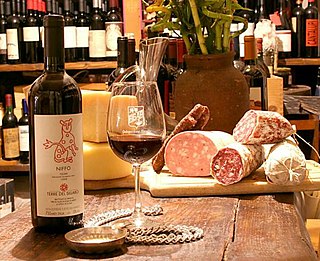
Salumi are Italian meat products typical of an antipasto, predominantly made from pork and cured. Salumi also include bresaola, which is made from beef, and some cooked products, such as mortadella and prosciutto.

Casunziei is the name in Ladin for a type of stuffed pasta, consisting of a filling sealed between two layers of thin pasta dough, folded in a typical half-moon shape. They are commonly homemade and are typical of the culinary tradition of the Dolomites area, in the northeastern part of Italy, especially the provinces of Belluno, Bolzano, and Trento.
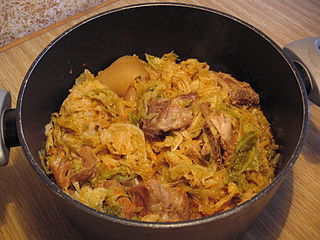
Lombard cuisine is the style of cooking in the Northern Italian region of Lombardy. The historical events of its provinces and of the diversity of its territories resulted in a varied culinary tradition. First courses in Lombard cuisine range from risottos to soups and stuffed pasta, and a large choice of second course meat or fish dishes, due to the many lakes and rivers of Lombardy.

The traditional cuisine of Abruzzo is eclectic, drawing on pastoral, mountain, and coastal cuisine. Staples of Abruzzo cuisine include bread, pasta, meat, fish, cheese, and wine. The isolation which has characterized the region for centuries has ensured the independence of its culinary tradition from those of nearby regions. Local cuisine was widely appreciated in a 2013 survey among foreign tourists.
Spongarda is a local cake originating in the comune (municipality) of Crema. The Lombardy region includes it as spongarda of Crema in the list of traditional food products.

Crescentine, crescente or tigelle are thin, 10 cm round breads from the Apennine Mountains, in the Modena area of Emilia-Romagna, Italy. They are made with flour, water, salt, and yeast, and traditionally eaten filled with cunza, a spread made from pork lard and flavoured with garlic and rosemary or with cold cuts, boar, rabbit, cheese, salty dressings or sweet spreads. In the Apennines, crescente have long been eaten at home or enjoyed in traditional restaurants, but in the last decade some fast food and casual restaurants have added crescente to their menus. Similar breads such as piadina, borlengo, gnocco fritto, and panigaccio are made in neighbouring areas.
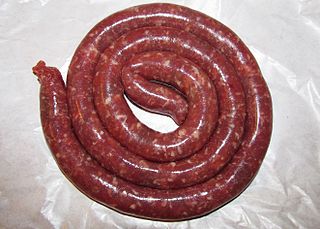
Bra sausage is a sausage recognized as a prodotto agroalimentare tradizionale (PAT). The sausage is produced in Piedmont, exclusively in the comune (municipality) of Bra, by butchers associated with the Consortium for the Protection and Enhancement of Bra Sausage.

Bardiccio, also known as bardiccio fiorentino or salsiccia matta, is a typical Tuscan cold cut, similar to burischio, whose preparation is based on the use of the less valuable and rich in blood parts of pork. Its typical dark red color depends on the quantity of heart—generally bovine—used in the mixture. Bardiccio has the characteristic shape of a sausage, but it is longer and is stuffed into a pork casing, tied with string. It is produced from September to May and is eaten unaged.

The cuisine of Basilicata, or Lucanian cuisine, is the cuisine of the Basilicata region of Italy. It is mainly based on the use of pork and sheep meat, legumes, cereals and vegetables, with the addition of aromas such as hot peppers, powdered raw peppers and horseradish. The local gastronomy is, for historical-cultural reasons, typically peasant, based on simple recipes and on the culture of reuse, in particular of meat and bread.
Cappello del prete is a variety of Italian salume typical of Parma and Piacenza. It is recognized as a prodotto agroalimentare tradizionale (PAT).
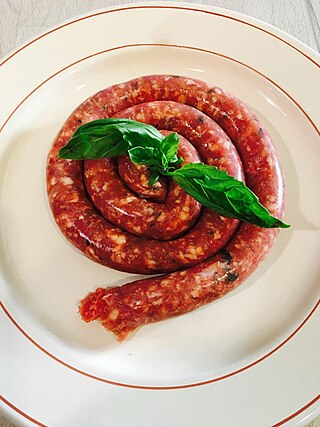
Zampina di Sammichele is a cold cut recognised as a prodotto agroalimentare tradizionale (PAT). It also holds the trademark of denominazione comunale d'origine (De.CO).
Mazzarelle is an ancient recipe typical of the Abruzzo tradition, widespread above all in the mountains, particularly in the Teramo area. It is listed as a prodotto agroalimentare tradizionale (PAT) by the Ministry of Agricultural, Food and Forestry Policies. Mazzarelle are rolls of lamb offal wrapped in endive leaves tied with casings of the same lamb.
Cuccalar is a typical bread from the Valle dei Mocheni in the Autonomous Province of Trento. Once widespread throughout the valley, today it is produced almost exclusively in the municipality of Palù del Fersina; it is protected as a prodotto agroalimentare tradizionale and is also listed in the Ark of Taste.

Panuozzo is an Italian sandwich of pizza bread stuffed with fillings of meat and vegetables. It was invented in 1983 by the pizzaiolo Giuseppe Mascolo, from the comune (municipality) of Gragnano, near Naples, Italy, and was first adopted in the region of the Monti Lattari. Various fillings can be used, such as mozzarella or other dairy products, tomatoes, several vegetables, Italian sausages and sliced meats, friggitelli, and so on.
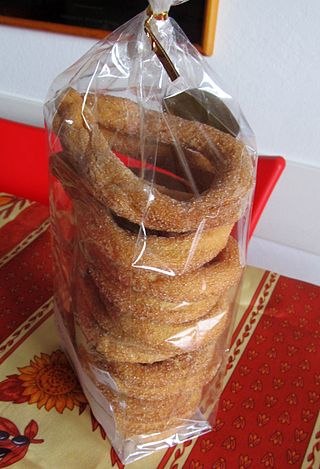
Torcetti are a type of yeasted cookie from the Northern Italian region of Piedmont. Torcetti have been classified as a traditional, protected Piedmontese product. They are most commonly made in Torino, the Lanzo Valleys, the Canavese region, and the Province of Biella. The name, which means "twisted" in Italian, derives from the twisted shape of the biscuits, which are similar to sweet version of grissini. Also related are the Saint-Vincent torcetti, produced in the Aosta Valley region.
